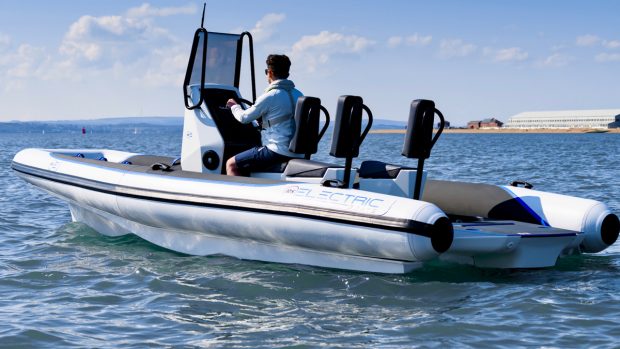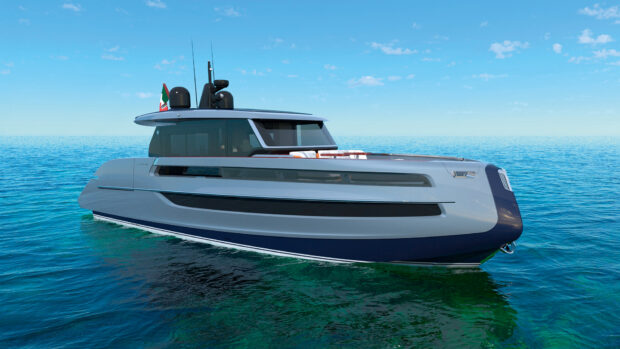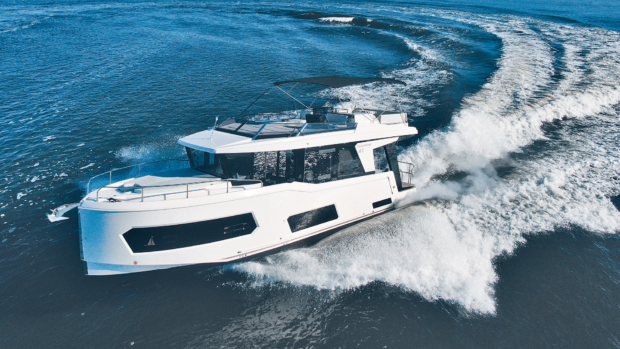Spirit of Cardiff turns its back on the Pacific as the crew prepares to make the relatively short trip to the Atlantic via the Panama Canal…
Spirit of Cardiff turns its back on the Pacific as the crew prepares to make the relatively short trip to the Atlantic via the Panama Canal? Clive Tully reports:
“On Tuesday we spend the day fuelling up, speaking to the media, and welcoming British Ambassador Jim Malcolm aboard. He’s with Ambassador Flavio Mendez from Panama’s Ministry of Foreign Affairs, and Mort Deas from Halcrow, the Swindon-based company which advises on the maintenance of the Panama Canal. The whole stop was originally set up at the instigation of Julian Johanson-Brown at Halcrow in Swindon, to whom we’re deeply grateful.
After they’ve had a good look at the boat, we’re whisked over to the Balboa Yacht Club, where a reception has been arranged for us. Even there it’s pretty hectic, with more press and TV interviews. We eventually get our breakfast at about 10.30pm.
Wednesday morning, and we’re up bright and early to get the boat ready for our special passengers. British Ambassador Jim Malcolm and Mort Deas are doing part of the journey with us. The boat is loaded down with food for the passage to Jamaica, massive ropes and fenders for use in the locks, and we’ll also have a pilot and two line handlers aboard.
It’s just after 9.00am, and the first highlight of the day is passing under the Bridge of the Americas, a Tyne Bridge look-alike which spans the entrance to the canal, overlooked by Ancon Hill, with its massive Panamanian flag flying proudly in the breeze.
We’re going through with two other vessels, the Marion Dufresne, a large French polar research ship, and the Falkor, a plush motor yacht which is going to take out a lot of the stress of the locks. Although we have a pilot, two line handlers and positively yards of thick blue polypropylene rope, we’re going to tie up to the larger Falkor, and let their line handlers do all the work.
Despite our assurances that Spirit of Cardiff is surrounded by one large fender, they decide to lower their fenders – smart rental jobs made of car tyres wrapped in bin liners and parcel tape.
Just past 10.00am, and the French ship has entered the first chamber of the Miraflores Locks, and fifteen minutes later Falkor and Spirit are in the chamber behind it, along with a couple of tug boats. The lock workers throw thin lines with weights at the end called monkeys. The handlers on the boat catch them, slip the monkey through the loops in their heavy duty ropes, and then allow the guys ashore to drag them up to make fast at the top of the lock. The guys ashore obviously have to practice twirling these things to get their aim good, and it helps if the line handlers on the boat are good at catching. Fortunately I’m out of a job on that front.
Five minutes later, the gates have shut behind us, and the water level is rising rapidly. Ten minutes after that, and we’ve risen to the top of the lock, with Marion Dufresne moving out ahead of us into the next chamber. Knowing where the webcam is situated, we’ve been waving at it, in the knowledge that a request had been put in specifically to have it pointing at us. Unfortunately it was struck by lightning in a storm over the weekend, and they couldn’t zoom it in on us, hence the rather distant speck of yellow just about visible on the PC screens of anyone trying to follow our progress through the lock.
Whilst we motor through the locks under slow power, larger ships are towed through by amazing locomotives – each of which I’m told cost a million dollars – on rack and pinion railways. Really big ships may have four locomotives on each side.
At 10.40, we’re making our way into the second chamber of the Miraflores Locks. Just ten minutes later, and we’re approaching the top of the lock, where we see a public viewing platform bustling with people, including a few of our supporters from Tuesday night.
Out of that chamber, and then we head along under our own steam, still tied to Falkor, arriving at the next locks, the Pedro Miguel Locks, at 11.30. Fifteen minutes later, the heavens open. Suddenly the lock workers are running for cover. This isn’t what I’d expect of people who ought to be used to tropical rainfall. It’s short lived, though. By midday we’re out the other side, and we cast off from the Falkor, so we can drop off our two passengers. Ambassador Jim Malcolm and Mort Deas have been really helpful to us, and great company – we’re sorry to see them go.
The next section is known as the Culebra Cut. This is the narrowest part, crossing the Continental Divide. They’re in the process of widening this bit, and when it’s finished, the whole canal will be capable of taking two-way traffic – at the moment, northbound transits start in the morning, southbounds in the afternoon.
At Gamboa, we pass an interesting piece of working industrial heritage, the Titan. Painted a mean and moody black, it’s the largest floating crane in the world, built in Nazi Germany. We didn’t get the chance to go ashore and see, but apparently many of the components still have swastikas moulded in them.
From here the cut opens out into the Gatun Lake, which actually supplies Panama City with all its fresh water. There’s a fair breeze blowing across here, so it’s quite bumpy. It’s fringed with dense forest, and once again it’s wildlife spotter Steve who’s first to spot a Cancun Alligator on one of the banks.
By 2.15pm, we’ve arrived at the entrance to the final set of locks. Only problem is we’re an hour ahead of schedule, so we moor up to a buoy, get the kettle out, and have a brew up.
Just after 3.00pm, and we’re rafted up once again to the Falkor, following Mario Dufresne into Gatun Locks. Once inside I hop on board Falkor to take advantage of her extra height to look out over the top of the lock gates, the chamber below, and beyond that, the Port of Cristobal and the Caribbean.
We finish our transit of the Panama Canal within eight hours, and without doubt it’s been one of the highlights of the trip – from soaking up the wonderful scenery along the way, to marvelling at the fantastic feat of engineering of the canal locks.
A lot of people worked hard to make our stop in Panama something special and very memorable, and we’ll be publishing a full thank you list in due course. In the meantime, a very big thanks to everyone who made us so welcome.
And if nothing else, I’ve had one illusion shattered. You can’t buy a decent Panama hat in Panama. The good ones are all made in Ecuador, and exported to the posh shops in Britain!”







